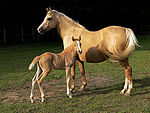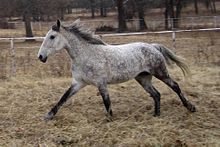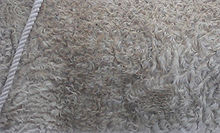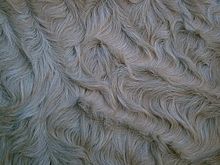- Curly Horse
-
Curly 
Bashkir CurlyDistinguishing features Curly coat, mane, tail, fetlocks and inner ear hair Alternative names American Bashkir Curly, North American Curly Horse, and American Curly Horse Country of origin North America Common nicknames Curly Horse (Equus ferus caballus) A Curly is a breed of horse. Curlies, also called Bashkir Curlies, American Bashkir Curlies, and North American Curly Horses, come in all sizes, colors, and body types but all carry a gene for a unique curly coat of hair.[1]
Contents
Traits
The Curlies are known for their calm, intelligent and friendly personality. They show an easily trainable temperament. They are also known for having a tough constitution and great stamina. Most people have found that the curlies enjoy being around people. The curlies are typically not flighty. They tend to do more reasoning than most breeds. They are very reliable and have a great work ethic.[2]
Coat, mane and tail
The unique gene that gives Curlies their curly hair (which is most obvious with their winter coat) can be expressed minimally (horse exhibits curly hair inside ears, at fetlocks, and a kinky mane and tail), maximally (horse exhibits curl all over body, has dreadlocked mane, and has curly eyelashes and guard hairs), and "Extreme" (very tight, extreme curls, but when they shed out for summer can shed entirely bald) or any variation in between. The coat in the summer shows a slight wave in it, but not as extreme as the winter curls.[2]
Because the trait can be carried heterozygously, some purebred Curlies exhibit no curl at all. (Called "smooth coat" curlies)[3]
Curlies have split manes and are not braided or clipped when shown. Curlies are most commonly chestnut colored, but can be found in every color from standard bays, blacks, and greys, to appaloosa markings; from pinto patterns to dilute colors such as buckskin, roan, grulla, and cremello.[4][5]
The care for the curly hair is simple. Most people choose to not comb the mane because the hair will lose its curliness. The manes are often trimmed to keep them from matting. The tails can be combed. Some people choose to collect the hair that is shed from the mane and tails in the spring. The hair is then donated to the ICHO Fiber Guild. They use the hair for spinning. All of the proceeds go to ICHO Curly Research Efforts.[2]
Hypoallergenic
Curlies are acclaimed to be the only hypoallergenic horse breed; most people allergic to horses can handle Curly Horses without suffering any allergic reaction. Research indicates a protein is missing from the fur of Curlies which may be what causes allergic reactions to horses in allergy suffers, but the study was never officially published. Members of the Curly Community are working towards funding more research on this.[6]
Build
The Curly has a characteristic long stride and bold movement. They have tough hooves, strong bones and exceptional endurance. Most Curlies stand between 14 and 16 hands, though they can range from Miniature horses to Draft horses (Only allowed in two registries).
Origin
The origins of the Curly horse is highly debated in the Curly community, but research is mostly still in progress. Disagreements of the Curly horse's history result in confusion of what the breed is, and what it should be called. ABCR members prefer "Bashkir Curly" while CSI & ICHO members lean towards "North American Curly". The addition or removal of 'Bashkir' to the breed name is highly debated.[7]
It is said that Curly horses were documented in Asian artwork as early as 161 AD. Charles Darwin documented curly horses in South America in the early 19th century and the early Sioux Indians regarded curly horses as sacred mounts for chiefs and medicine men. Native American artwork shows Curlies carrying warriors in the Battle of Little Bighorn.[citation needed]
Another theory is that the origin of the breed is Iberian.[8] It has been noted that foals of cross bred horses have the curly hair. This suggests that the curly gene is dominant.[2]
There are multiple theories for how the American Curly developed. The Curly horse was first documented in Eureka, Nevada in the early 20th century by rancher John Damele and his sons. While Mustangs were a common sight, curly coated horses were unusual. Years later, the Dameles managed to catch one, broke it to ride and sold it, thus starting their relationship with the breed. In 1932, an unusually harsh winter hit the area, and come spring the only horses that could be found were the Curlies. This evidence of hardiness was noted by the Damele family, and they decided they should include more of these horses in their herd. After another harsh winter in 1951/52, the Dameles started to get serious about breeding these horses. They went out and found their foundation stallion, a two year old chestnut in one of the mustang herds. They called him Copper D. The Dameles didn't care much for keeping the breed 'pure', and wanting to improve their horses, added some other blood to their herd. Among the stallions introduced were a Morgan, Ruby Red King AMHR 26101 and an Arabian, Nevada Red AHR 18125. These two stallions created many offspring for the Dameles, and are in hundreds of Curly horses' pedigrees today.[9]
Registries and organizations
The American Bashkir Curly Registry (ABCR) opened in 1971 with only 21 horses; as of May 2005 there were just over 4,000 Bashkir Curlies in the world, primarily in North America. They are the original standing Curly Registry, and have a closed stud book- only issuing new registrations to horses with two ABCR registered parents.[10]
The International Curly Horse Organization (ICHO) began in 2000 and had over 800 horses registered in its North American Curly Horse Registry (as of Oct. 2006). Horses within this registry are not referred to as "Bashkir Curlies". Although bloodlines (when available) are tracked, the ICHO registers horses based on visible curly traits rather than bloodlines.[11]
Curly Sporthorse International (CSI) began in early 2003 to promote sport horse type Curly Horses, which are one of the more popular types of Curlies. CSI was created to support Curly owners & breeders in improvement of breeding stock, promotion, & marketing. The registry also sponsors Horse of the Year awards and USDF All Breed Awards for performance. CSI advocates evaluation of breeding stock & their offspring.[12]
Canadian Curly Horse Association (CCHA) formed in 1993. This group is focused on community events in the Curly world, and spreading knowledge of the Curly horse.
Uses
Though eye catching and unusual in the show ring, Curlies have the movement, endurance, and heart to excel in competition. Curlies have been shown at upper levels of dressage and show jumping, and others have proved the reliable mount and patient teacher for the weekend competitor. Curlies are characteristically quiet, level headed horses that make excellent first horses for supervised beginner riders. Curlies have carried horse-allergic riders from beginner status through ever more advanced stages of equestrianism. They have also been used for combined driving, western riding, ranch horses, trail horses, and companions for other horses. Some Curlies have been crossbred to gaited horses. About 10% of the crossbreds will do one of the ambling gaits such as the running walk, fox trot or the stepping pace, which is also called the "Curly shuffle." Curlies are not used for racing or high trotting showing.[2]
See also
References
- ^ "Curly genetics". Mindspring.com. http://www.mindspring.com/~ebancroft/curlygenetics.htm. Retrieved 2010-06-25.
- ^ a b c d e "Curly Horse FAQ". Curlyhorses.org. http://www.curlyhorses.org/index.php?page=faqcurly. Retrieved 2010-06-25.
- ^ "ICHO About Curlies". Curlyhorses.org. http://www.curlyhorses.org/index.php?cat=89. Retrieved 2010-06-25.
- ^ "ABC Registry Breed standard". Abcregistry.org. http://www.abcregistry.org/breed_id_standard.htm. Retrieved 2010-06-25.
- ^ "NACHR Breed Standard". Curlyhorses.org. http://www.curlyhorses.org/index.php?page=breed_standard. Retrieved 2010-06-25.
- ^ "ICHO Allergy Information". Curlyhorses.org. http://www.curlyhorses.org/index.php?cat=68. Retrieved 2010-06-25.
- ^ "Article To B or not to B". Curlyhorses.org. http://www.curlyhorses.org/index.php?page=37. Retrieved 2010-06-25.
- ^ "Iberian Origins of New World Horse Breeds". Jhered.oxfordjournals.org. doi:10.1093/jhered/esj020. http://jhered.oxfordjournals.org/cgi/content/full/97/2/107. Retrieved 2010-06-25.
- ^ "History". Curlytranch.ca. 1961-01-14. http://www.curlytranch.ca/history.html. Retrieved 2010-06-25.
- ^ "American Bashkir Curly Horse Registry". Abcregistry.org. http://www.abcregistry.org. Retrieved 2010-06-25.
- ^ "ICHO/NACH Registry Requirements". Curlyhorses.org. http://www.curlyhorses.org/index.php?page=registration. Retrieved 2010-06-25.
- ^ "CSI". Curlysporthorse.org. 2009-11-25. http://www.curlysporthorse.org. Retrieved 2010-06-25.
External links
- American Bashkir Curly Registry
- International Curly Horse Organization
- Curly Sport Horse International Registry
- Canadian Curly Horse Association
- Curly Horse Pedigree Database
Equine Equine science and
management
Equestrianism
and sportGlossary of equestrian terms · List of Equestrian Sports · Horse tack · Bit · Bridle · Saddle · Harness · English riding · Western riding · Driving · Horse training · Horse racing · Equestrian at the Summer Olympics (medalists, venues) · Horse show · EquitationEvolution and history Domestication · In warfare · In the Middle Ages · Horses in East Asian warfare · History of the horse in South Asia · Horses in the Napoleonic Wars · Horses in World War I · Horses in World War II · History of the horse in BritainHorse breeds, types
and other EquidaeList of horse breeds · Wild horse · Feral horse · Stock horse · Gaited horse · Draft horse · Warmblood · Sport horse · List of horse breeds in DAD-ISOther EquusHybridsCategories:- Horse breeds
Wikimedia Foundation. 2010.



